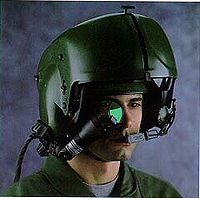
Photo from wikipedia
INTRODUCTION Aircrew viewing eyepiece-injected symbology on color display night vision goggles (CDNVGs) are performing a visual task involving color under highly unnatural viewing conditions. Their performance in discriminating different colors… Click to show full abstract
INTRODUCTION Aircrew viewing eyepiece-injected symbology on color display night vision goggles (CDNVGs) are performing a visual task involving color under highly unnatural viewing conditions. Their performance in discriminating different colors and responding to color cues is unknown. METHODS Experimental laboratory measurements of 1) color discrimination and 2) visual search performance are reported under adaptation conditions representative of a CDNVG. Color discrimination was measured using a two-alternative forced choice (2AFC) paradigm that probes color space uniformly around a white point. Search times in the presence of different degrees of clutter (distractors in the scene) are measured for different potential symbology colors. RESULTS The discrimination data support previous data suggesting that discrimination is best for colors close to the adapting point in color space (P43 phosphor in this case). There were highly significant effects of background adaptation (white or green) and test color. The search time data show that saturated colors with the greatest chromatic contrast with respect to the background lead to the shortest search times, associated with the greatest saliency. Search times for the green background were around 150 ms longer than for the white. Desaturated colors, along with those close to a typical CDNVG display phosphor in color space, should be avoided by CDNVG designers if the greatest conspicuity of symbology is desired. DISCUSSION The results can be used by CDNVG symbology designers to optimize aircrew performance subject to wider constraints arising from the way color is used in the existing conventional cockpit instruments and displays.Liggins EP, Serle WP. Color vision in color display night vision goggles. Aerosp Med Hum Perform. 2017; 88(5):448-456.
Journal Title: Aerospace medicine and human performance
Year Published: 2017
Link to full text (if available)
Share on Social Media: Sign Up to like & get
recommendations!